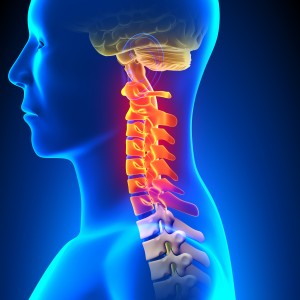Whiplash Pain -3 Common Causes
 Whiplash Pain And It’s Cause
Whiplash Pain And It’s Cause
Whiplash is a common term used to describe the type of injury someone suffers when they are involved in a car accident. This term is used to describe what is believed to be the mechanism of how the injury occurs: a “whipping” of the head forward and back. (See how the neck deforms during impact). The most common car accident is a “rear end” collision or when one car is hit from behind by another traveling at a greater speed. The force of the impact then travels through the struck vehicle to the passengers, causing sudden jarring motions of the neck and upper body. It is this sudden force that produces the injuries to the occupant’s neck.
Neck Structure
The neck is comprised of seven vertebra and are labeled as C1-C7 (C standing for cervical), beginning with the first vertebra under the skull. From with the second vertebra (C2) through C7, each one attaches to the one below it in three places: the disc in front and two small joints in the back called facet joints. Overlying the bones are a series of tough leather like tissue known as ligaments: their job to tightly hold the vertebra together. Then, over the ligaments is a series of muscle layers that are responsible for the actual movement of our neck.
Whiplash Pain
The pain of a “whiplash” injury results from injury and damage to one or more of these structures: the disc, facet joints, ligaments or muscles. Typically, than one structure and multiple levels are injured.
Strain
A strain is the mildest and simplest injury suffered in a “whiplash injury.” A strain is when a muscle or it’s tendon is forcibly and quickly stretched beyond it’s normal ability and causes microscopic tearing of the fibers.
In some ways, you can view a muscle like a rubber band: it has a normal ability to stretch and return to it’s normal shape. However, you can quickly stretch it beyond it’s ability and it then does not return to it’s normal shape.
While a strain is probably the simplest injury, there are various grades of strain and each requires a specific time frame of treatment and healing.
Sprain
A sprain is when one or more of the supporting ligaments is stretched or torn. Unlike muscles, ligaments do not have as much elasticity: they are designed to tightly hold the bones together. Once stretched, they do not easily regain their normal strength and in most instances, they heal with a significant amount of scar tissue.
An added significance of a damage to a ligament is the affect it can have on the joints of the neck. If a ligament is injured and becomes slack, it cannot hold the bones tightly together, allowing an abnormal motion to develop in the joints between the bones. This abnormal motion can be a source of stress on the joint producing pain and increasing the likelihood for earlier degenerative changes.
Facet Joints
Probably the most common cause of moderate to severe whiplash pain is due to a facet joint injury. These small joints are located at the back of the vertebra and surrounded by a ligament capsule that helps to maintain a lubricating fluid in the joint. The facet joints are responsible for the normal position and motion of the vertebra and neck motion.
In a “whiplash” type injury, the facet joints go through a very forceful shearing motion: one part of the joints is jammed forward, while the other is jammed back. This shearing motion can damage the capsule, the joint lining and the joint surface itself.
Once damaged, inflammation and swelling begins as well as limited motion of the vertebra. This results in the painful, limited motion most victims experience after an injury. If not properly treated, facet injury can lead to increased risk of earlier arthritis of the neck joints.
Conclusion
While we have listed these three common causes of neck pain as separate entities, the reality is they typically are seen together. If a facet injury is present, it means there must have been damage to both the ligaments and muscles.
Proper treatment of these whiplash injuries requires consistent care focusing on restoring and maintaining the proper motion and alignment of the vertebra and joints (joint mechanics). Chiropractic care has been shown to be one of the safest and most effective treatments for “whiplash” type injuries. By gently working to restore normal mobility and alignment, chiropractic care effectively reduces or eliminates the pain.
If you have experienced a “whiplash” type injury, call our office today at (314) 731-4383 to set up an appointment to find out how chiropractic care can help.
